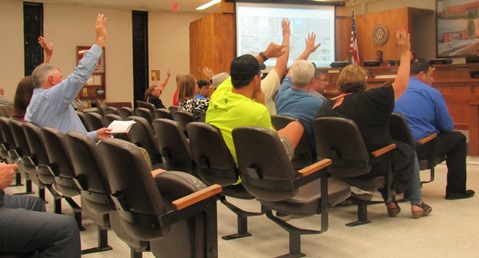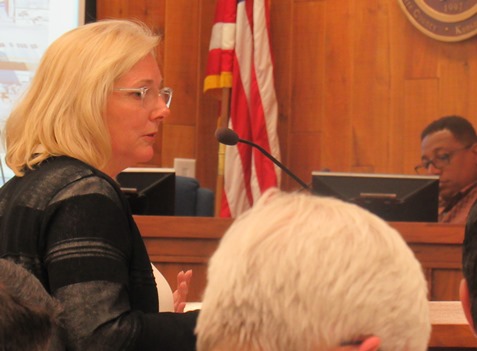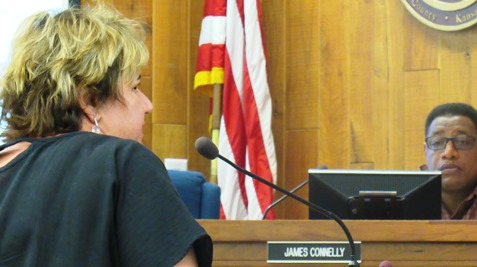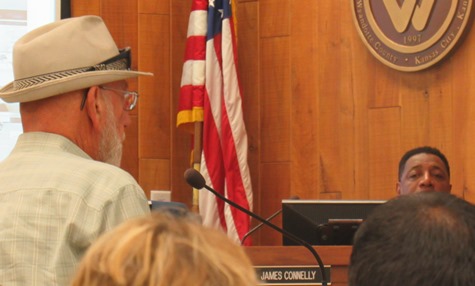
Despite opposition from Fairfax businesses, a new federal prison re-entry facility in the Fairfax industrial District moved forward in a unanimous vote of the Kansas City, Kansas, Planning Commission on Monday night.
The issue next goes before the Unified Government Commission for approval, and may be on the 7 p.m. June 29 agenda.

According to Terry Williams of ReEntry Development Inc., of Mandeville, La., the re-entry program would house about 85 male federal prisoners who are making the transition from prison to moving back to the community. The inmates will still be in the custody of the federal Bureau of Prisons while at the facility.
The prisoners in the program would be allowed to go to work and to school. Then, after some time, they might be allowed to have visitors on the weekend, she said. As they progress in the program, they might be allowed to make visits to their homes on weekends, according to Williams. Eventually, if successful, the inmates would be released from prison. The average stay is six months, with the shortest stay about a month, Williams said.
Williams told the Planning Commission Monday night that the federal re-entry programs her firm operates in Louisiana and Arkansas have an 83 percent success rate, and about 17 percent of the inmates go back to prison because they are not “programming.”
She was of the opinion that most of the inmates would not be a problem because they are close to completing their sentences and would not want to do anything to jeopardize being released. She also talked about community service projects they worked on.
Williams said the inmates at the re-entry facility would be from Wyandotte County, plus within a 100-mile radius around it. There are also re-entry programs in Kansas City, Mo., Topeka, Kan., and Wichita, Kan.
The re-entry facility would be staffed 24 hours a day, according to Williams. There would be about 25 staff members, with about 10 staff members present at a time, she said. It is a private facility that would have a contract with the Federal Bureau of Prisons.
The facility is on the bus line. Williams said when the inmates are on work release, if they don’t show up at work or if they don’t get back to the facility within a short time after they are expected there, an attempt will be made to find them, and if they are not found, the U.S. Marshals and Bureau of Prisons will be notified. Years could be added to their sentences if they walk away.
In answer to a question from Planning Commissioner James Connelly, Williams said when inmates arrive back at the re-entry facility after their work day, they go through a metal detector, they are searched and they are given a test that determines if they have been drinking. They also have bed checks.
Tony Privitera, who owns the building at 925 Sunshine Road, said he supported the location of the re-entry program to Fairfax. The building formerly was the Kansas City Workshop for the Blind. Privitera owns several other Fairfax buildings. He said while some businesses in Fairfax are manufacturing products, Williams is “manufacturing people.”
“I have the utmost confidence in this company,” Privitera said. He said he had probably the most to lose of anyone at the meeting, and he has vetted all his concerns about the project.
The re-entry facility also had support from two persons with the Doing Real Work program.

Melissa Clark, executive director of the Fairfax Industrial Association, told the Planning Commission that her board voted in May to oppose this special use permit for the prisoner re-entry program.
The FIA board concluded the re-entry program would have an adverse effect on the Fairfax district, she said. The district and area are already struggling with the perception it is unsafe because of its appearance and proximity to blighted neighborhoods, she said. Businesses that are interested in locating and businesses already in Fairfax have said there is difficulty in recruiting new employees because they do not feel safe, she added. Having the re-entry program at the corner of one of the three main entrances will have a negative impact, she said.
The Fairfax association’s concern that crime would rise was elevated, she said, as the patrol officer was pulled from the Fairfax district last summer because of a shortage of police officers, and they are not sure that any officers would be assigned there soon. The district is often vacant on nights and weekends, and with the federal re-entry program operating around the clock, the district might be exposed even more, she said.
Some of the largest businesses and industries in Fairfax have their own security guards. But some of the small businesses there have only one or two persons in a building, and they are very concerned for their safety.
The re-entry program’s location also was opposed by the Fairfax Drainage District board in a vote in April, said Steve Dailey, general manager. He said the board opposed the re-entry facility because it is in close proximity to 10 pumping stations along the levee, as well as the flood protection infrastructure, and because police coverage has already been reduced in the Fairfax district.
Dailey said the Fairfax Drainage District board determined opposition to the project was in the best interest of its constituents and its pump station operators, who work around the clock when the river is elevated, so as not to increase the risk to flood protection and the safety of its employees.
Lindsey Douglas, director of public affairs for Union Pacific Railroad, which has a large presence in the Fairfax district and a 24-hour a day operation, said there has been an uptick in the number of trespasser incidents. UP special agents, who are law enforcement officers, have expressed concerns about this re-entry facility, she said.
She said there is currently some illegal activity in Fairfax. In one recent incident, she said, there was a shootout with a car ending on UP railroad tracks, while UP employees had to shelter in place, lying on the floor. There were a number of incidents that have occurred, causing them to be concerned about this facility, she added.
Marty Quinn of Industrial Lumber discussed many business break-ins in the 1980s and 1990s and saw their insurance rates rise. Businesses have increased their security measures. “If you saw what we had to work with, we are the ones working in a jail,” he said.
If 260 people go through the re-entry program in a year, and if there is a 20 percent failure rate, he said, then there could be 50 people a year who are failing.
“I just don’t think it’s good for Fairfax or Kansas City, Kansas, to have this back in Kansas City,” he said.
Williams said over a 21-year span of the re-entry program in Arkansas, there were about nine or 10 inmates who walked away, and they didn’t stay in the area where they had been in the re-entry program. Most of the time they went to their girlfriend’s residence, but walking away could get them sent back to prison.

Joe Vaught, who is a commercial property broker and owner, as well as a former Kansas City, Kansas, council member and a former Unified Government commissioner, said he did not think the re-entry facility would enhance the ability to rent property in Fairfax. He has some property in Fairfax and also has shown some commercial properties there.
Vaught said he questioned the staffing level of the re-entry facility – a 25-person staff with 10 staff members there at any given time. He said it sounded lean.
Williams said that in Arkansas, when the re-entry facility went in to a residential area, crime went down in the area and property values did not decrease.
There was an earlier neighborhood meeting held in April about the re-entry facility. Williams said they also have met with a northeast neighborhood group and representatives of El Centro, the NAACP and the faith community.
Rob Richardson, UG planning director, said the UG planning staff recommended a two-year special use permit for the re-entry facility. Some of the stipulations were that the facility would not include convicted murderers or sex offenders. The Planning Commission vote was 5-0 in favor of the two-year special use permit for the facility.
No information was presented at the meeting about how much money it would cost the Unified Government to provide more police patrols in the Fairfax area, if the UG decides more patrols are advisable.
Although the Planning Commission meeting was scheduled to start at 6:30 p.m. Monday, it started after 8 p.m. because the Board of Zoning Appeals meeting, held prior to it in the same room, ran over. The item on the federal re-entry program did not come up for discussion until about 10:15 p.m., with the vote about 11:25 p.m.
